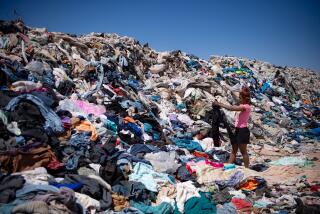Donated Apparel Processed by State-of-Art System : Clothes Sorter Tailor-Made for Mission
- Share via
SYRACUSE, N.Y. — It’s a rags-to-riches story, but Darlene Carrington isn’t riding around in a limousine or wearing a mink coat.
She’s too busy sorting old clothes.
Carrington is assistant director of the Rescue Mission’s Donation Redistribution Center, where a state-of-the-art sorter and a new building have brought assembly-line efficiency to the way donations of used clothing are handled.
The center handled nearly 2.5 million pounds of clothing in 1988, according to Kenneth Barber, director of operations for the nonprofit group. The operation nets about $1.2 million a year, with about $875,000 of that solely from clothes. The money supports the mission’s homeless shelter, alcohol rehabilitation centers, adult home and counseling and family service programs.
“Everybody--the Volunteers of America, the Salvation Army, Goodwill--collects old clothes,” says Clarence Jordan, the mission’s executive director. “But as far as I know, this equipment is state-of-the-art for any rescue mission.”
Work of Board Member
Jordan says the $34,000 conveyor system, similar to that used by hospitals and laundries, is the work of mission board member Peter Meier.
Meier, president of a company that builds institutional laundry equipment, persuaded Sam Gardner, a North Carolina colleague, to design and build the system. Gardner donated more than $100,000 in design, labor and installation costs.
“It wasn’t too long ago that we used a pitchfork to bale clothes,” says Jordan. “Now we just push a button. A computer eye tells it when to move toward the baler.”
About 30% of the clothes donated are good enough to be resold at the mission’s eight Thrifty Shopper stores. The rest are bound into 1,200-pound bales and sold for about 6.5 cents a pound to salvage dealers in New York, New Jersey and Canada. Each month the mission processes about four truckloads of salvage, each carrying 35 to 40 bales.
National salvage figures are hard to come by, but Al Wilson, the mission’s salvage broker, who operates out of Atlanta, estimates the business at 150 million pounds per year.
Varied Market
Jordan says white cottons, resold as absorbent wipers, fetch the highest prices. Dyed cottons are next, sold to automotive companies as colored wipers. Wool knits are exported to Italy, where the wool is unraveled and re-woven into new garments. Man-made fibers fetch the lowest prices.
As with any export business, salvage prices are sensitive to the value of the dollar and other fluctuations in international markets. Jordan says the mission’s salvage business almost collapsed in 1984, when they could barely get a penny a pound for the clothes.
That pushed the group to examine their methods. In 1985, they switched from donation boxes--which Carrington says were local eyesores--to eight manned donation centers. Since then, she reports that both the quality and the quantity of donations has soared.
As for the rest of the operation, it was back to retailing basics.
Only the best clothes go to the stores, according to Carrington. Merchandise, neatly arranged, is turned over seasonally. Unsold items are marked down after eight weeks, and at 10 weeks are given away through the center’s community programs.
The mission moved into its 40,000 square feet of new space in downtown Syracuse this past summer. Carrington says that with the new conveyor system, they have doubled to 10,000 items the number of pieces they can handle in a week.
One of the mission’s next goals is to collect more men’s clothing.
“Women wear clothes for a season, kids grow out of clothes in a year,” says Carrington, “but men wear their clothes until they die.”
More to Read
Sign up for Essential California
The most important California stories and recommendations in your inbox every morning.
You may occasionally receive promotional content from the Los Angeles Times.













